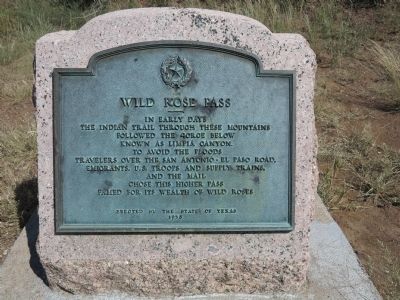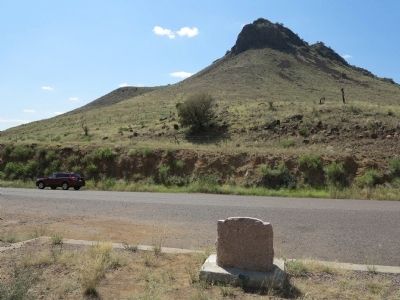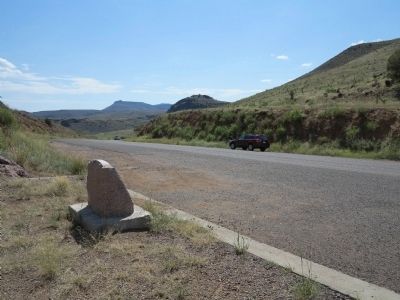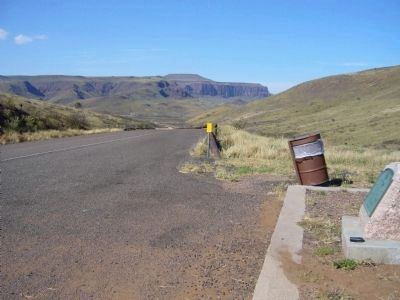Fort Davis in Jeff Davis County, Texas — The American South (West South Central)
Wild Rose Pass
Erected 1936 by State of Texas. (Marker Number 10490.)
Topics and series. This historical marker is listed in these topic lists: Hispanic Americans • Native Americans • Wars, US Indian. In addition, it is included in the Antonio de Espejo Entrada of 1582-1583, the San Antonio-El Paso Road, and the Texas 1936 Centennial Markers and Monuments series lists.
Location. 30° 42.893′ N, 103° 46.939′ W. Marker is in Fort Davis, Texas, in Jeff Davis County. Marker is on Wild Rose Pass (State Highway 17) 1.3 miles south of Powell Ranch Road, on the left when traveling south. Touch for map. Marker is in this post office area: Fort Davis TX 79734, United States of America. Touch for directions.
Other nearby markers. At least 8 other markers are within 11 miles of this marker, measured as the crow flies. Granado Mountain (approx. 9.3 miles away); Barry Scobee Mountain (approx. 9.3 miles away); Supporting the Army (approx. 10.3 miles away); The Post Chapel (approx. 10.3 miles away); Legend - Fort Davis (approx. 10.4 miles away); Commanding Officer's Quarters (approx. 10.4 miles away); St. Joseph Catholic Church (approx. 10.4 miles away); Fort Davis (approx. 10.4 miles away). Touch for a list and map of all markers in Fort Davis.
Regarding Wild Rose Pass. In reference to the Indian trail mentioned on the marker, in 1583 Spanish explorer Antonio de Espejo, on his return journey south from New Mexico, planned to follow the Pecos River from near present Pecos, Texas to the pueblos at La Junta de los Rios (where the Concho River of Mexico joins the Rio Grande at present day Presidio, TX and Ojinaga, Mexico). He was dissuaded from this route by Jumano Indians he encountered on Toyah Creek (near Pecos, TX), and shown a more direct route - part of their own north-south trade route - through what are now the Davis Mountains: leaving the Pecos River travelling up Toyah Creek valley, past San Solomon Spring at present day Toyahvale, TX, through Wild Rose Pass, along Limpia Creek to what is now Fort Davis, TX, then south to La Junta de los Rios. The Jumanos: Hunters and Traders of the South Plains by Nancy Parrott Hickerson
Related markers. Click here for a list of markers that are related to this marker. Markers relating to the San Antonio - El Paso Road & Ft. Davis
Also see . . . Wild Rose Pass. Handbook of Texas Online (Submitted on September 23, 2012, by Richard Denney of Austin, Texas.)
Credits. This page was last revised on January 17, 2024. It was originally submitted on September 23, 2012, by Richard Denney of Austin, Texas. This page has been viewed 1,388 times since then and 74 times this year. Last updated on January 16, 2024, by Jeff Leichsenring of Garland, Texas. Photos: 1, 2, 3. submitted on September 23, 2012, by Richard Denney of Austin, Texas. 4. submitted on November 19, 2012, by Bill Kirchner of Tucson, Arizona. • James Hulse was the editor who published this page.



